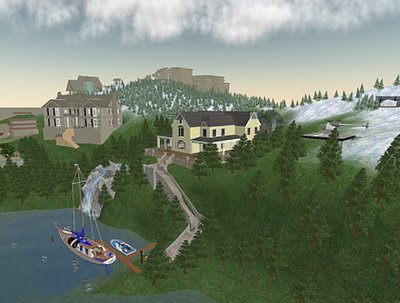A new year has begun – in First Life and in Second Life, too. What was most surprising to me – though, maybe it should not have come as a surprise - are the similarities between those two worlds. It was the first Holiday Season I spent in Second Life. Before it started, I was wondering if residents activities would slow down – because they would be occupied with First Life obligations – or if it would be the busiest time of year in SL, too. The second assumption seems to be true. Nearly every numerical record imaginable was broken: in world sales volume, number of residents, concurrent residents, turnover at the LindeX etc. The SL economy – like the First Life economy – seems to heat up enormously in these last weeks of the year.
That is very interesting “news” in itself. At least it is to me, who still feels like a newbie after less than 12 months in this world. It is a clear indicator that for many residents SL is not “just a game”. It is part of their life. And they spend these weeks frantically buying presents – for others and for themselves - doing bigger investments, spending more – not less - time in world, decorating their houses according to the season and so on. The true “Citizens of the Metaverse” even spend lots of Christmas – and New Years Eve, too – in Second Life, partying, chatting, dancing, generally having a good time; with their SL families and the friends they made in world. A look at the number of residents online on the evening of the 23rd, the 25th and the 31st or December showed numbers not significantly smaller than on other weekend evenings (3,500 to nearly 4,000). Only the evening of the 24th (around 3,000 concurrent users) seems to be focused on First Life.
I know many people who would shudder in horror at these numbers and talk of socially inept, isolated people living in a cold, cold world of bits and bytes far from the “real” world of warm social relations with “real” people. I am not sure of that diagnosis. Some relationships in Second Life seem very real to me (others not, buts that’s not so much different from “real” life). But at least those numbers show that “Second Life as a business environment” gets more and more interesting – and bigger; more details on that aspect below.
The last month was not only one of growth and of frantic shopping but included some other interesting events in the economic segment of our little world, too. I refrain from repeating all of those I mentioned in my previous weekly posts, but would like to mention - among others:
- The Killing of the Telehubs
- Compensation for Poor Landbarons
- The End of the Developer Incentive
- Breaking the 100,000 Barrier
- New Land on the Horizon
- Linden Lab working the (Money) Printing Press
But first ... the raw numbers:
Cold facts
In the last month the official population of Second Life grew from some 16% from around 91,000 to nearly 106,000. In the same time the average number of concurrent users present inworld at 8pm SL time grew some 10%. It has been more than 4,400 concurrent users on average in the last days – which might still be small compared to other MMOGs but signifies a dramatic growth over the course of the last year, too. And exponential growth is a funny thing. If these growth rates were sustainable (which they are probably not) this would result in more than half a million residents and nearly 15,000 concurrent users at the end of 2006.

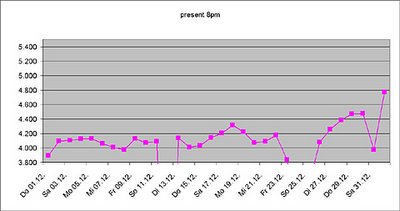
The number of concurrent users inworld grows rapidly but not as fast as the number of residents
Some residents tend to talk these numbers low as “just PR fog”. The argument usually is, that many of those residents will leave SL soon, and the number of premium accounts does not grow nearly as fast. That is be true. But even all those basic accounts spending only a little time inworld for a while are driving the inworld economy. It is a different kind of user base but surely an interesting one for all those selling something to these users – be it virtual goods, land or services. All the other indicators clearly show that this growth is no PR stunt.
The average daily trading volume at the LindeX grew from something around or below 4 Mio. L$ to now 5 Mio. L$ per day. That is nearly 19,000 US$ per day at current exchange rates; some 450,000 US$ over the course of December.  The exchange rate was relatively stable over the whole month at 266L$/US$ with some small peaks.
The exchange rate was relatively stable over the whole month at 266L$/US$ with some small peaks. The daily inworld trading volume (“US$ Spend Today”) signalled on the homepage was more than 200.000 US$ over the last two weeks (I only measure that number since mid December). This is a (unbelievable) large number and I really would love to interview Lawrence Linden about what is measured here exactly. Every resident (not only active ones) would have to spend 2$/day to get this results. But no matter what is measured exactly, the trend is showing upward, too.
LindeX in overview
More detailed data for the SL economy will appear in one or two weeks on the SL website. A more detailed analysis will have to wait since then.
And now back to "events" mentioned:
The Killing of the Telehubs
This month showed the end of the telehub based transportation system in SL. With Version 1.8 every user can now jump directly (with exceptions) to any point in the world of Second Life. This was announced in November and implemented in mid December. It was – and will be – very significant for the SL economy. Location – at least nearness to a telehub is not important for a shop anymore. All the land around the telehubs lost value dramatically. The L$ lost more than 5% of its value in the days after the announcement and has not recovered.
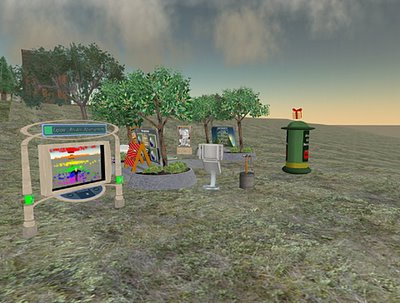 One of the new "Infohubs"
One of the new "Infohubs"
And while the “fans of P2P teleporting” are already rejoicing in the fact that “everything is much better now and nothing bad has happened” I would say that it’s still a little early to decide on that. This is a dramatic change to the basic laws of the world SL. And it will have changes besides some added convenience. These changes surely will not mean the end of the world. But in two or three months we will see that aspects of Second Life with no apparent connection to telehubs will have changed. Some businesses will profit, others not.
Compensations for Poor Landbarons
If you like changes to the basic SL rules seems to depend a lot on what is your way of earning money in SL – and whom you despise. This was clearly visible when the Killing of the Telehubs was announced and all those hating “The Land Barons” were singing the song of “it’s their own fault”, when it became clear that some land holders would get dramatic financial problems - not Anshe, the most hated land holder of all, I would like to add; her activities are diversified enough. Others suffered much more. But this seemed not to matter much to the Anshe-Haters.
This pattern became obvious in a depressing kind of way, when Robin Linden finally announced the compensation program for telehub land: an offer of buying back land within 128m around telehubs at 10L$ per sqm. I am not sure myself if this was necessary. At least it is a dangerous precedent: Nearly every change in SL is bad for some business owners (and maybe beneficial for others). Will every significant feature change lead to a rally for compensatory measures from now on?
On the other hand the absolute damage was relatively high in this case and the fact that Linden Lab already had made the decision to switch off the telehubs while it was still profiting from the higher land prices at the auctions might justify some kind of moral obligation to do something in compensation. The effect was predictable, though: the land-baron-haters fumed and cited occasions in the past where other kinds of businesses suffered and got no compensation. “Unfair!” was the battle cry: “If they get some money I demand compensation for past (and future) damages, too!”
Many arguments pro and contra were exchanged, which had a reasonable sound to it on the surface. The facts are hard to judge, actually. There are many similarities between this and past cases of Linden induced changes (or glitches) and many differences, too. But if you followed the wording of the posts on the forums a little more closely it was much too apparent that no matter what argument was brought forth, the land-baron-haters would accept nothing that indicated compensation being a sensible decision. And most of the owners of telehub land obviously considered the compensation not enough because telehub land usually was much more expensive than 10L$ per m2. A saddening display of group egotism and sometimes personal hatred – induced by wounds from past battles maybe.
These behavioural patterns do not make the Lindens job of steering the economy any easier. The continued success of Second Life depends on both “factions” (and many others): the “creators” and the “land barons” IMHO.
The End of the Developer Incentive
Even though it was not discussed as vehemently and emotionally loaded as P2P teleporting the end of the Developer Incentive could well be of similar importance to the SL economy. Many business plans (if written down or not) currently are dependent on the check Linden Lab pays out every month to those land owners enjoying the most traffic (or dwell) on their land. This check will become smaller in January and February and will disappear in the spring of 2006.
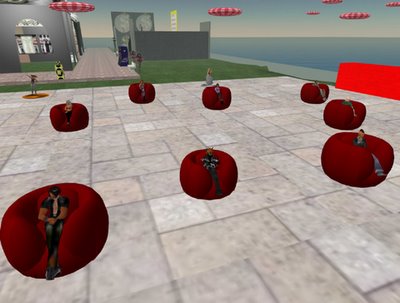
Camping chairs, a nice way to earn some easy money
(most of the residents in this picture are "away")
The end was expected by many after the camping chair phenomenon took over half of SL. But IMHO Camping chairs just made clear that dwell (traffic) is not a very good measurement if the activities of a resident do help Linden Lab in achieving its business goals. That was the purpose of the original developer incentive and has been perverted (gamed) for some time already; like any subsidy will always be gamed, in First Life or in Second. It remains to be seen what the effect of this change will be. Business will be harder for many clubs and many shop owner who counted on the DI as an additional source of income. On the other hand, camping chairs and similar systems already made sure, that without such bait there was not much dwell/developer incentive to be earned anyway.
It is probable that some residents, who depended largely on the incentive payments will have to tier down to compensate for that missing income. That would be bad for these projects, especially the non-profit ones. And that’s a least one reason, why I think that there has to be “some” way for the lindens to encourage some projects. Maybe a system of “grants” could do this. But I can already hear the cries of “favouritism” rising … From a purely economic viewpoint the abandoning of the old form of developer incentive was probably a very sensible move. It has been some time since the money spend for that was really helping to make Second Life a more attractive or interesting environment. This money can surely be invested in a much better way!
Breaking the 100,000 Barrier
Many residents sneered on the “event” or finally having 100,000 residents in SL (counting only avatars that were logged in in the last 30 days), dismissing this number as bloated. This is true in a way. Nonetheless it is an important mark in the history of the platform and I just hope that Linden Lab will use it in its PR activities.
For all those interested in the economic side of Second Life this number is a further signal for the incredible dynamic of SLs growth process. While this market is still small in absolute numbers (for some comparative data have a look here), this dynamic makes Second Life a very exciting environment for any hotblooded entrepreneur. Growth rates of 10% per month are something you rarely see in any market. And every day new kinds of business ideas are tested, some inspired be First Life models, some very specific and uniqe to our virtual world. I see these businesses as another expression of creativity that SL brings forth, a different kind of "creativity" than that expressed by a fashion designer or builder but creativity nonetheless.
New Land on the Horizon
It fits perfectly that nearly at the same time this barrier was broken, a new landmass has been discovered in the southwest of the map. The New Continent in the north is complete and the growth of the continent did come to a standstill when the Northern Continent was discovered. Maybe it will be revived now - or another continent will be discovered. One way or the other, new land is needed for all the new residents - and as a driving force of the SL economy.
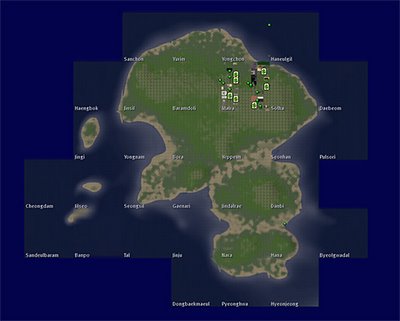 The new southwest landmass
The new southwest landmass
Thats why I don't see it as a good sign, that not a single sim has been auctioned off between Christmas and New Year. I hope it is just a symptom of the land baron/baronesses waiting for "new" land - or tiredness at years end. I hope this, because a depression in the land market would be bad for all of SL, nozt just the hated land barons. More then 10% of the SL economy is selling/buying land (not taking into account the growing rental market) and I bet that a lot of the remaining 90% is fuelled by the money made in this market segment.
Linden Lab working the (Money) Printing Press
One other event besides the dormant auction market is darkening my mostly bullish view of the SL economy, though. I was a very small event, if one can call it an "event" at all. It was an answer of Robin Linden to an inquiry of a suspicious resident:
Aaron Levy: Is Linden Labs going to create the L$ to buy back the land or will Linden Lab actually buy the L$ from their own exchange for these transactions?
Robin Linden: We will create the L$. We anticipate the actual amount that goes into the economy will be fairly small relative to other sources, such as weekly stipends.
While Robin may be correct in stating that the absolute amount will not greatly affect the Linden$ value, I was a little shocked at the open admittance of this practice. A government that simply “prints“ some more money whenever it needs cash, displays a very dangerous attitude towards economic stability. Whenever such a policy guided a government in the past (in First Life), it lead to inflationary phases in the countries economy with nearly all citizens suffering. (This was one of the decisive factors for establishing the relatively independent Federal Banks of most modern states.) Printing money seems like such a simple solution at first … while it is no solution at all.
Whats worse is, that this kind of “solution” is obviously not applied here for the first time. Many of those wonderful Linden projects which are be build by residents are paid for in L$ - and now I am rather sure that these L$ are "manufactured on demand".
I wonder, how this attitude could take hold in a company that so much emphasizes the economic side of Second Life.
 The new Celestial Store. No, you can't see in this picture, what I am describing in this article. It has to be "felt" ...
The new Celestial Store. No, you can't see in this picture, what I am describing in this article. It has to be "felt" ...


